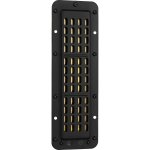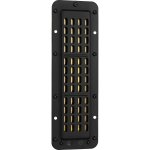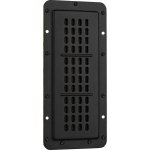Hello, I posted this this question over under Planars & Exotics but it's been a day and I'm not sure how much longer the drivers will be on Sale... and no one has commented so I thought maybe someone here might know about line Arrays ----
- I was over at Parts Express and saw these new Planar speaker drivers that are on Sale the model is GRS PT6816-8 8 inch Planar Slim Tweeters , their Frequency Response is 320 to 20,000hz , I am thinking of using 7 or 8 of them in a Line Array as Tweeters .... and then match them with maybe 7 or 8 of the GRS PT6825-8 8 inch Planar Mid//Tweeters as the Midranges which are on Sale too ....... I was wondering if the tweeters can be mounted close enough to each other to avoid any major Lobing issues? - Thanks in advance .
GRS PT6816-8 Tweeters
- https://www.parts-express.com/GRS-PT6816-8-8-Planar-Slim-Tweeter-8-Ohm-272-128
GRS PT6825-8 Tweeter/Midranges
- https://www.parts-express.com/GRS-PT6825-8-8-Planar-Mid-Tweeter-8-Ohm-272-126
- I was over at Parts Express and saw these new Planar speaker drivers that are on Sale the model is GRS PT6816-8 8 inch Planar Slim Tweeters , their Frequency Response is 320 to 20,000hz , I am thinking of using 7 or 8 of them in a Line Array as Tweeters .... and then match them with maybe 7 or 8 of the GRS PT6825-8 8 inch Planar Mid//Tweeters as the Midranges which are on Sale too ....... I was wondering if the tweeters can be mounted close enough to each other to avoid any major Lobing issues? - Thanks in advance .
GRS PT6816-8 Tweeters
- https://www.parts-express.com/GRS-PT6816-8-8-Planar-Slim-Tweeter-8-Ohm-272-128
GRS PT6825-8 Tweeter/Midranges
- https://www.parts-express.com/GRS-PT6825-8-8-Planar-Mid-Tweeter-8-Ohm-272-126
Attachments
-- Hello, I found some interesting drivers on sale over at Parts Express and thought they might work as a cool Open baffle Line Array , I originally posted this question over on "Planars & Exotics" , yesterday but no one has come by and I don't know how much longer the drivers will be on sale so i thought maybe someone over here might know the answer whether they will work or not... so here are the questions -
- I was over at Parts Express and saw these new Planar speaker drivers that are on Sale the model is GRS PT6816-8 8 inch Planar Slim Tweeters , their Frequency Response is 320 to 20,000hz , I am thinking of using 7 or 8 of them in a OB Line Array as Tweeters .... and maybe 7 or 8 of the GRS PT6825-8 8 inch Planar Mid//Tweeters as the Midranges which are on Sale too ....... I was wondering if the tweeters can be mounted close enough to each other to avoid any major Lobing issues? -
- What are peoples opinions on the idea ,
- I am hoping with 7 or 8 of the Midranges they could be crossed somewhere around there 250hz point , I would be supplementing with OB Woofers / Subwoofers too.
GRS PT6816-8 Tweeters
- https://www.parts-express.com/GRS-PT6816-8-8-Planar-Slim-Tweeter-8-Ohm-272-128
GRS PT6825-8 Tweeter/Midranges
- https://www.parts-express.com/GRS-PT6825-8-8-Planar-Mid-Tweeter-8-Ohm-272-126
-
- I was over at Parts Express and saw these new Planar speaker drivers that are on Sale the model is GRS PT6816-8 8 inch Planar Slim Tweeters , their Frequency Response is 320 to 20,000hz , I am thinking of using 7 or 8 of them in a OB Line Array as Tweeters .... and maybe 7 or 8 of the GRS PT6825-8 8 inch Planar Mid//Tweeters as the Midranges which are on Sale too ....... I was wondering if the tweeters can be mounted close enough to each other to avoid any major Lobing issues? -
- What are peoples opinions on the idea ,
- I am hoping with 7 or 8 of the Midranges they could be crossed somewhere around there 250hz point , I would be supplementing with OB Woofers / Subwoofers too.
GRS PT6816-8 Tweeters
- https://www.parts-express.com/GRS-PT6816-8-8-Planar-Slim-Tweeter-8-Ohm-272-128
GRS PT6825-8 Tweeter/Midranges
- https://www.parts-express.com/GRS-PT6825-8-8-Planar-Mid-Tweeter-8-Ohm-272-126
-
Attachments
I have gone down this path before. Sixteen years ago I built a near field line array which had 9 Aurum Cantus ribbon tweeters and 12 4.5" small woofer/midrange drivers per side.
The tweeters were mounted in a slot so that their frames were touching which minimizes any separation between them. They are connected in groups of 3 drivers in series and then the three sets connected in parallel. Thus the overall impedance of the tweeter array is the same as for an individual driver which was 8 ohms.
The 12 small woofers per side are connected in four paralleled sets of three drivers each so that the overall impedance is 6 ohms when arrayed.
An active three-way DSP crossover was used to crossover between the tweeters and mid-ranges and separate subwoofers (one per side).
My near field line array white paper (NFLAWP) was written to describe my work on line arrays in the early 2000's. It is still effective for your project.
A photo of my arrays is at: http://greatplainsaudiofest.com/Photos/CSSLineArray01.jpg
The NFLAWP is at: http://www.audioroundtable.com/misc/nflawp.pdf
The tweeters were mounted in a slot so that their frames were touching which minimizes any separation between them. They are connected in groups of 3 drivers in series and then the three sets connected in parallel. Thus the overall impedance of the tweeter array is the same as for an individual driver which was 8 ohms.
The 12 small woofers per side are connected in four paralleled sets of three drivers each so that the overall impedance is 6 ohms when arrayed.
An active three-way DSP crossover was used to crossover between the tweeters and mid-ranges and separate subwoofers (one per side).
My near field line array white paper (NFLAWP) was written to describe my work on line arrays in the early 2000's. It is still effective for your project.
A photo of my arrays is at: http://greatplainsaudiofest.com/Photos/CSSLineArray01.jpg
The NFLAWP is at: http://www.audioroundtable.com/misc/nflawp.pdf
Last edited:
Hello, thank you for stopping by,
I went to take a look at your paper that you referenced and found this ......
-------------------
- " Ribbon/planar Drivers with Minimal Overlapping Dispersion. As pointed out earlier, the 80% ARF criterion stated by Urban [1] assumes overlapping vertical coverage from discrete drivers. This criterion does not strictly apply to short planar or ribbon sources. While a single, long ribbon can easily cover the listening area with a sound field that extends from sitting to standing listening heights, shorter ribbon/planar tweeters can be stacked in an array to cover the listening area. Each short tweeter in the stack would have full sound coverage within that flat, cylindrical shaped volume slice—150 mm (6”) active height is typical--of the listening room. Below and above the active area of each tweeter (beyond the ~150 mm height) you may have gaps caused by the frames of the individual elements. Many of these sources have inherently limited vertical dispersion beyond the active area of each driver so little sound from an individual source overlaps the sound fields from adjacent drivers. Furthermore, any sound field overlap tends to diminish as frequency increases. This means that the efficiency gain of the array is minimized and only weak or no comb lines form. While you can often discern the amount of vertical sound field overlap for these drivers from manufacturer’s data, measurements are needed for final design implementation. The performance of a stack of short ribbon tweeters is akin to a long ribbon driver with intermittent gaps in the line. These gaps in the radiated sound from the stack are problematical but easily mitigated. If the radiated sound is measured vertically up and down an intermittent line of short tweeters within a one meter distance, response dips at Ó2003 James R. Griffin All Rights Reserved 15 a frequency that corresponds to two wavelengths spacing between the active areas of adjacent elements would be noted in the vertical pattern. But, if this line probed at a greater distance, then these vertical response dips tend to fill-in as enough vertical dispersion radiates from the sources at very low angles from the ends of each driver’s active region to cover these gaps. This effect is illustrated Figure 10. For example, one degree additional vertical radiation will fill-in 50 mm (2”) gaps between adjacent drivers at a 3 m (9.8 feet) listening distance. Therefore, as the group of these tweeters are stacked in a line, the sound field wedges or slices from each tweeter become continuous and cover the entire vertical volume in your listening room from the bottom to the top tweeter. While these flat sound volumes have minimal overlap that may offer little improvement in overall SPL of the array, neither are significant comb lines formed "

- ( Amazing job on the paper ) -
- Have some medical conditions and am on significant morphine , is this correct ? - thank you for your help - 🙂
Ps. -- in saying you have been down this path before 16years ago, does that mean you didn't like the speaker or your results??
----
I went to take a look at your paper that you referenced and found this ......
-------------------
- " Ribbon/planar Drivers with Minimal Overlapping Dispersion. As pointed out earlier, the 80% ARF criterion stated by Urban [1] assumes overlapping vertical coverage from discrete drivers. This criterion does not strictly apply to short planar or ribbon sources. While a single, long ribbon can easily cover the listening area with a sound field that extends from sitting to standing listening heights, shorter ribbon/planar tweeters can be stacked in an array to cover the listening area. Each short tweeter in the stack would have full sound coverage within that flat, cylindrical shaped volume slice—150 mm (6”) active height is typical--of the listening room. Below and above the active area of each tweeter (beyond the ~150 mm height) you may have gaps caused by the frames of the individual elements. Many of these sources have inherently limited vertical dispersion beyond the active area of each driver so little sound from an individual source overlaps the sound fields from adjacent drivers. Furthermore, any sound field overlap tends to diminish as frequency increases. This means that the efficiency gain of the array is minimized and only weak or no comb lines form. While you can often discern the amount of vertical sound field overlap for these drivers from manufacturer’s data, measurements are needed for final design implementation. The performance of a stack of short ribbon tweeters is akin to a long ribbon driver with intermittent gaps in the line. These gaps in the radiated sound from the stack are problematical but easily mitigated. If the radiated sound is measured vertically up and down an intermittent line of short tweeters within a one meter distance, response dips at Ó2003 James R. Griffin All Rights Reserved 15 a frequency that corresponds to two wavelengths spacing between the active areas of adjacent elements would be noted in the vertical pattern. But, if this line probed at a greater distance, then these vertical response dips tend to fill-in as enough vertical dispersion radiates from the sources at very low angles from the ends of each driver’s active region to cover these gaps. This effect is illustrated Figure 10. For example, one degree additional vertical radiation will fill-in 50 mm (2”) gaps between adjacent drivers at a 3 m (9.8 feet) listening distance. Therefore, as the group of these tweeters are stacked in a line, the sound field wedges or slices from each tweeter become continuous and cover the entire vertical volume in your listening room from the bottom to the top tweeter. While these flat sound volumes have minimal overlap that may offer little improvement in overall SPL of the array, neither are significant comb lines formed "
- ( Amazing job on the paper ) -
- Have some medical conditions and am on significant morphine , is this correct ? - thank you for your help - 🙂
Ps. -- in saying you have been down this path before 16years ago, does that mean you didn't like the speaker or your results??
----
Last edited:
My latest line array experience is documented in my thread on a Modified CBT24. I listen to these arrays daily.
https://www.diyaudio.com/community/threads/my-new-line-array-its-a-modified-cbt24.313352/
Jim
https://www.diyaudio.com/community/threads/my-new-line-array-its-a-modified-cbt24.313352/
Jim
Last edited:




 Duplicate threads merged.
Duplicate threads merged.